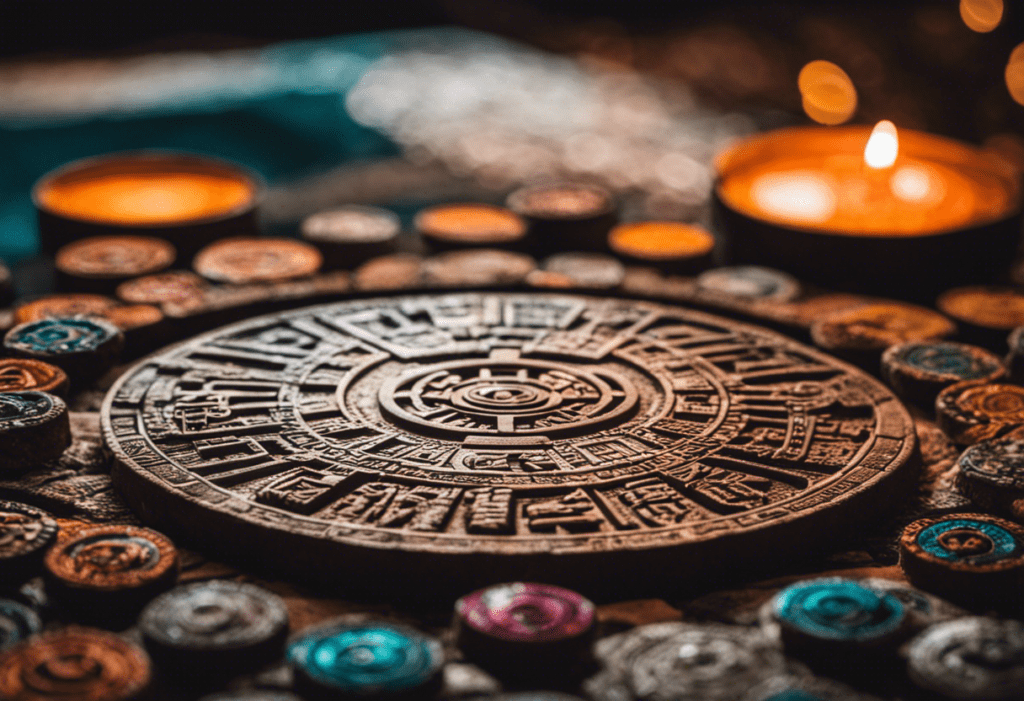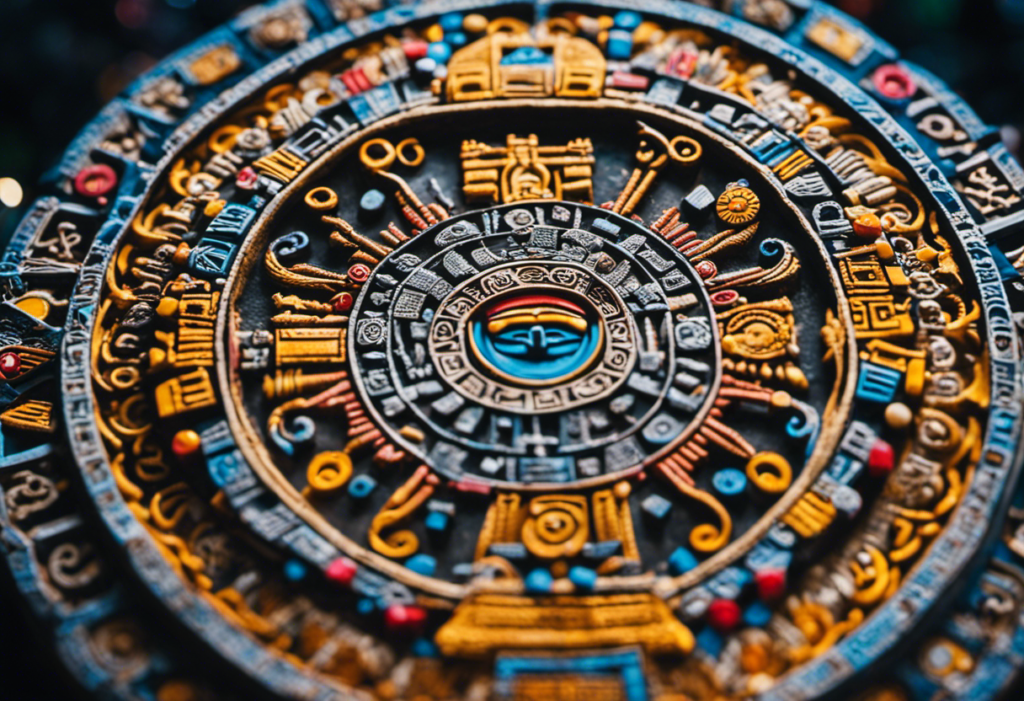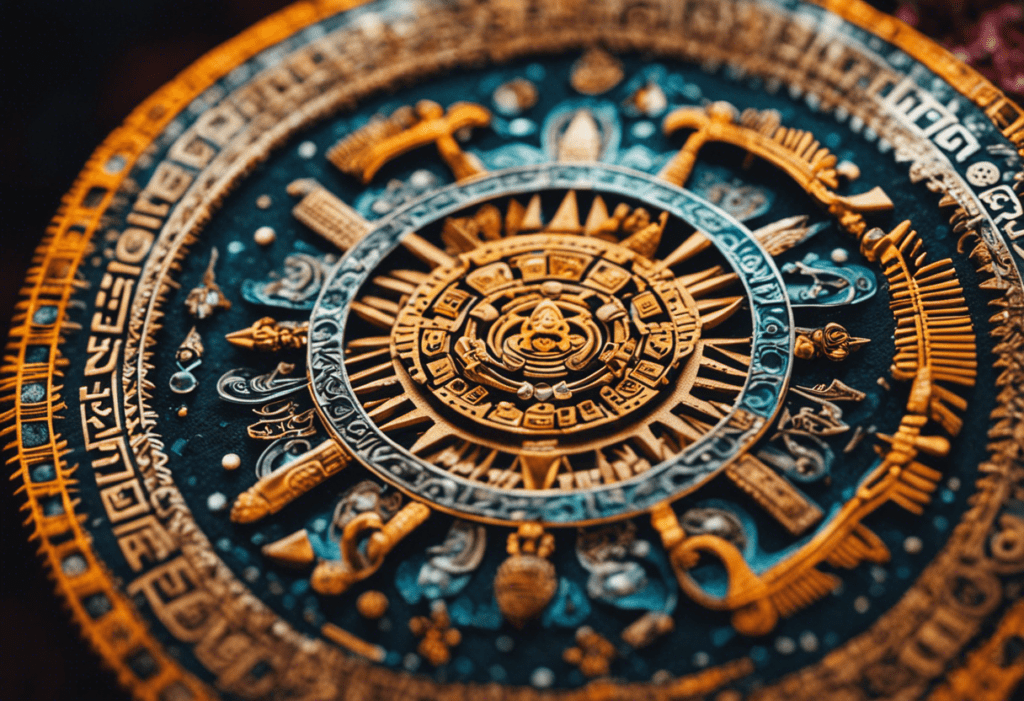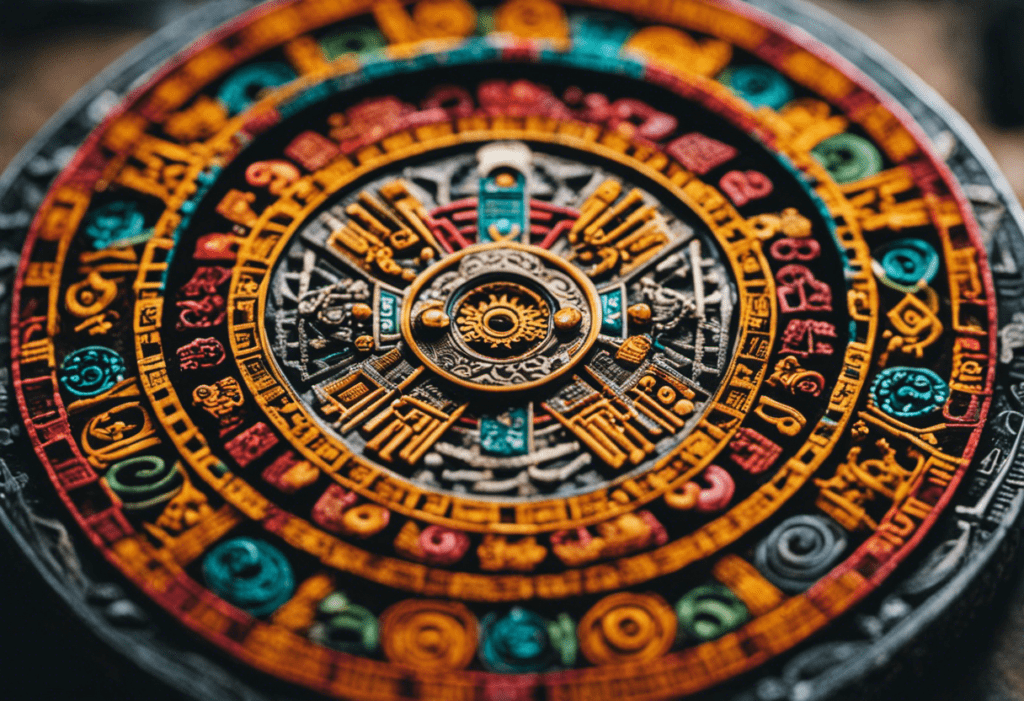Unveiling the mysteries of the Aztec Calendar Stone, a remarkable artifact that captivates scholars and enthusiasts alike.
This intricately carved stone, with its rich symbolism and profound cultural significance, offers a window into the ancient Aztec civilization.
Through a meticulous decoding of its intricate carvings and a deep understanding of the Aztec calendar system, we can begin to unravel the profound mysteries concealed within.
Join us as we embark on a journey to explore the origins, meanings, and societal role of the Aztec Calendar Stone.
Key Takeaways
- The Aztec Calendar Stone was created by the Aztecs and used for timekeeping, celestial events, religious ceremonies, and agricultural cycles, demonstrating their advanced knowledge in astronomy and mathematics.
- The carvings on the Calendar Stone represent elements of Aztec cosmology, providing insights into their belief system and understanding of the universe.
- The carvings depict celestial and earthly elements, symbolizing the interconnectedness of the cosmos and the earthly realm, and reflect the rich cultural heritage of the Aztecs.
- The Sun God, Tonatiuh, is associated with light, power, and the source of all life, and required human sacrifices to appease and ensure the Sun’s rising, highlighting the importance of the sun in Aztec religious practices.
The Origins of the Aztec Calendar Stone
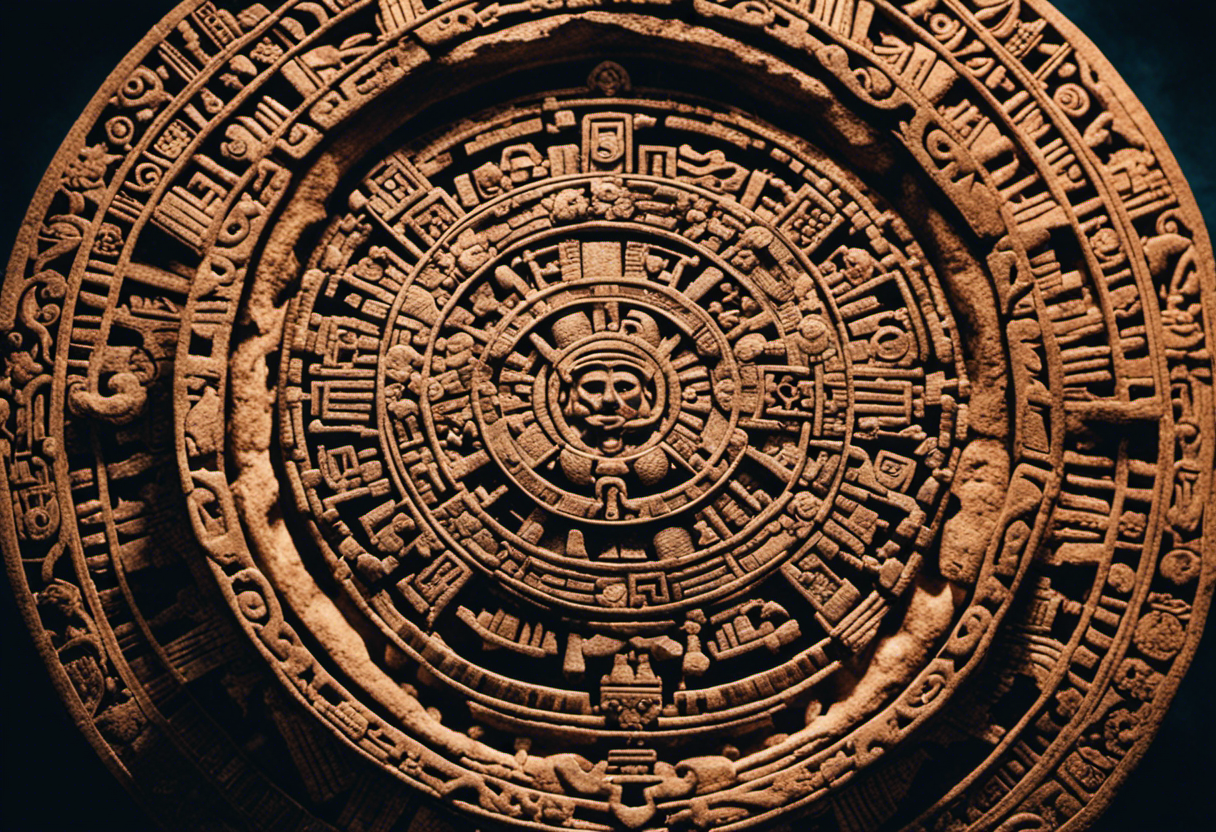

The Aztec Calendar Stone’s origins can be traced back to ancient Mesoamerican civilizations. This remarkable artifact, also known as the Sun Stone, was created by the Aztecs, a civilization that flourished in present-day Mexico from the 14th to the 16th century. The Aztecs were renowned for their advanced knowledge in various fields, including astronomy and mathematics, which is evident in the intricate design of the Calendar Stone.
The historical significance of the Aztec Calendar Stone lies not only in its artistic beauty but also in its function as a complex timekeeping device. The stone measures nearly 12 feet in diameter and weighs approximately 24 tons, highlighting the impressive craftsmanship of the Aztecs. It is believed that the Calendar Stone was used to track the passage of time, mark important celestial events, and determine religious ceremonies and agricultural cycles.
The Aztec Calendar Stone’s design features a central disc depicting the sun god Tonatiuh, surrounded by various intricate symbols and glyphs representing important celestial bodies, deities, and significant dates. The stone’s meticulous carvings demonstrate the Aztecs’ sophisticated understanding of astronomical phenomena and their deep connection with the natural world.
The origins of the Aztec Calendar Stone exemplify the ingenuity and artistic prowess of the ancient Mesoamerican civilizations. Its historical significance lies in its role as a timekeeping device and its representation of the Aztecs’ advanced knowledge in astronomy and mathematics.
Decoding the Intricate Carvings


The intricate carvings on the Aztec Calendar Stone hold symbolic meanings and have a significant historical importance.
Each carving represents different elements of the Aztec cosmology, including gods, celestial bodies, and natural elements.
Decoding these carvings provides valuable insights into the Aztec belief system and their understanding of the universe.
Symbolic Meanings Behind Carvings
Numerous intricate carvings on the Aztec Calendar Stone hold profound symbolic meanings that can be deciphered through careful analysis. The carvings on the stone reflect the rich cultural interpretations of the Aztec civilization, offering insights into their religious beliefs, cosmology, and understanding of time.
Modern day interpretations of the Aztec calendar stone also shed light on its significance as a representation of the Aztec worldview and their complex understanding of the universe. The symbolic meanings behind the carvings evoke a sense of awe and wonder, inviting us to explore the depths of ancient knowledge and spirituality.
The carvings depict various celestial and earthly elements, such as gods, animals, plants, and natural phenomena, representing the interconnectedness of the cosmos and the earthly realm. The intricate details and symbolism of the carvings on the Aztec Calendar Stone continue to captivate and inspire curiosity about the ancient Aztec civilization.
- � Celestial deities and their powers
- � Sacred animals and their significance
- � Depictions of agricultural practices and fertility
- ⚡ Symbolism of natural phenomena like storms and lightning
- � Representation of religious rituals and sacrifices
Historical Significance of Carvings
Through careful analysis and interpretation, the intricate carvings on the Aztec Calendar Stone reveal the historical significance and cultural significance of this ancient artifact. These carvings provide valuable insights into the historical context of the Aztec civilization.
The stone’s carvings depict various celestial and mythological symbols, which were important aspects of Aztec cosmology and religious beliefs. The carvings also showcase the artistic techniques employed by the Aztecs, such as their mastery of stone carving and their attention to detail. The precision and complexity of the carvings on the Calendar Stone demonstrate the advanced artistic skills of the Aztecs.
Furthermore, the carvings depict important historical events such as the reigns of specific rulers and the Aztec belief in cyclical time. Overall, the carvings on the Aztec Calendar Stone serve as a historical record and a testament to the rich cultural heritage of the Aztec civilization.
The Symbolic Meaning Behind the Sun God
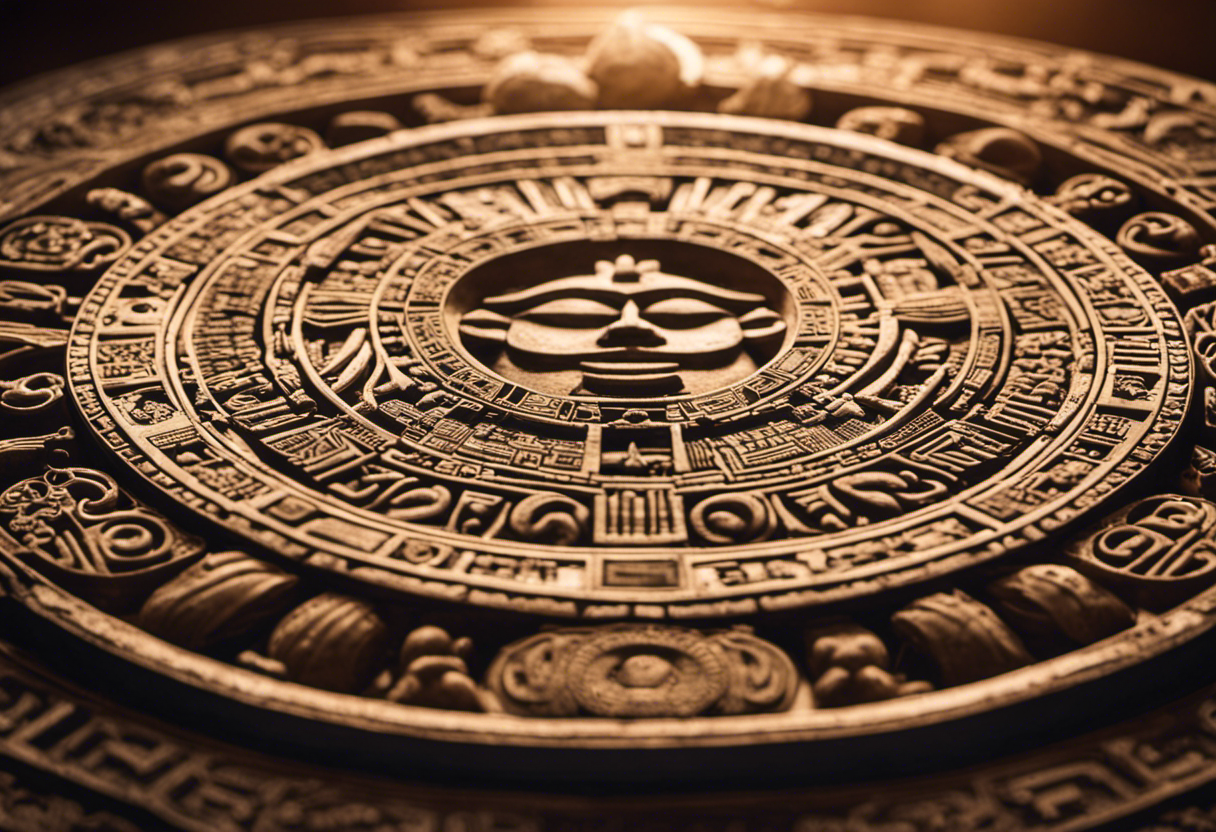

With its rich symbolism and cultural significance, the Sun God holds a prominent position in Aztec mythology and offers profound insights into their beliefs and rituals. The Sun God, known as Tonatiuh, was considered the most important deity in the Aztec pantheon. He was believed to be the source of all life and the ruler of the heavens. The Aztecs saw the Sun as a powerful force that provided light, warmth, and nourishment to the world. They believed that through the Sun God, they could maintain a harmonious relationship with the natural world and ensure the continuance of their civilization.
The symbolic representation of the Sun God in Aztec art and iconography is evident in various forms. Here are five key aspects that highlight the religious importance of the Sun God:
- The Sun God was often depicted as a young warrior with a solar disk on his head and rays emanating from his body, symbolizing his association with light and power.
- Tonatiuh was believed to require human blood to sustain his strength and vitality, and human sacrifices were made to appease him and ensure the Sun’s rising each day.
- The Sun God’s journey across the sky represented the eternal cycle of day and night, life and death, and was seen as a metaphor for the continuous renewal and regeneration of the natural world.
- The Sun God was closely associated with agricultural fertility, as the Aztecs believed that his warmth and energy were essential for the growth of crops and the abundance of harvests.
- The Sun God was also linked to the concept of divine kingship, as the Aztec rulers claimed descent from him and saw themselves as earthly representatives of his power and authority.
Understanding the Aztec Calendar System
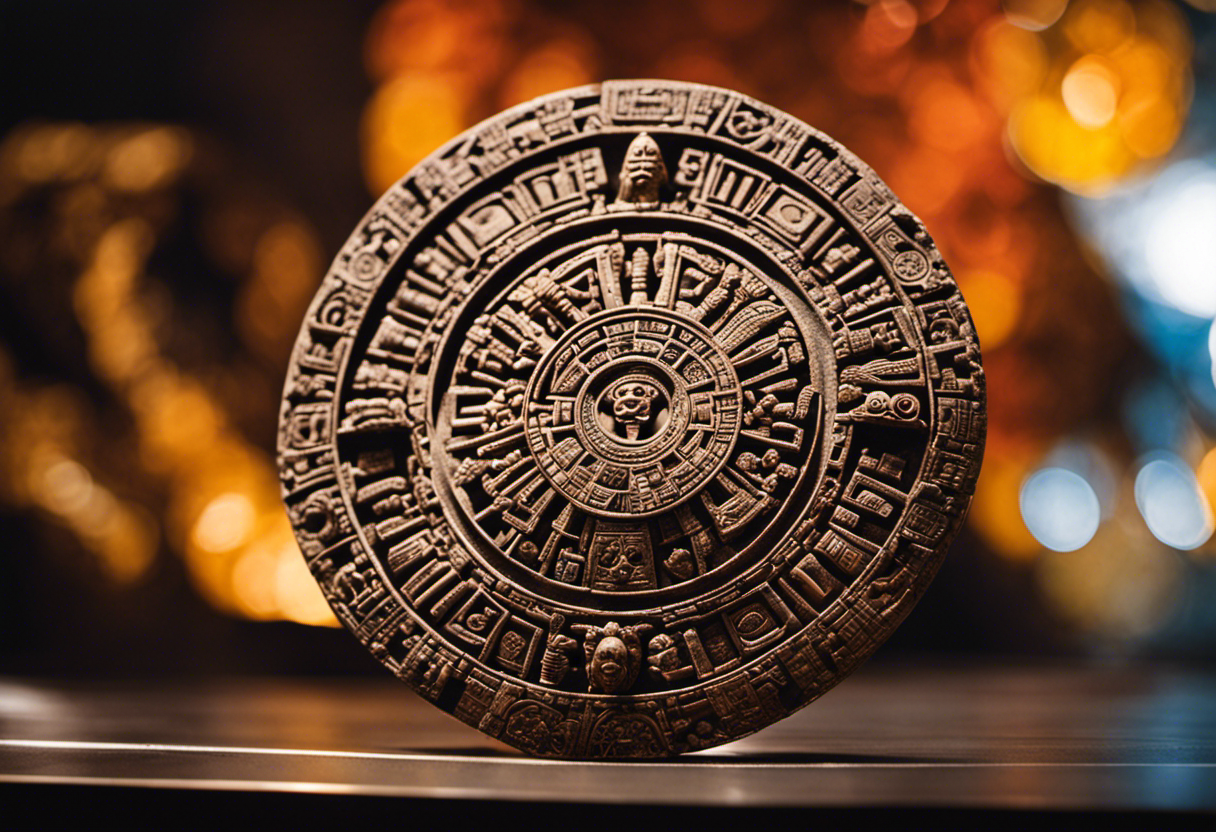

The Aztec calendar system, characterized by its intricate design and astronomical precision, provides a fascinating glimpse into the sophisticated understanding of time and the cosmos held by the Aztec civilization. The Aztecs had a complex calendar that consisted of multiple interlocking cycles.
One of the most important cycles was the 365-day solar year, known as the xiuhpohualli. This calendar was divided into 18 months of 20 days each, with an additional five unlucky days at the end. The Aztecs believed that each day had its own unique energy and significance, and they performed various rituals and ceremonies to honor and appease the gods associated with each day.
The Aztec calendar also included a 260-day ritual calendar, known as the tonalpohualli. This cycle was made up of 20 periods of 13 days, each represented by a different symbol. These symbols were believed to have a direct influence on human destiny, and individuals would consult the calendar to determine the most auspicious days for important events such as marriage, childbirth, and warfare.
In addition to these calendars, the Aztecs also used a long-count calendar, which measured time in cycles of 52 years. This calendar was crucial for predicting cosmic events such as solar eclipses and the movements of celestial bodies.
The intricate symbols and rituals associated with the Aztec calendar system reflect the profound spiritual and cosmological beliefs of the Aztec civilization. Through their calendar, the Aztecs sought to understand and navigate the cyclical nature of time, as well as to establish a connection with the divine forces that governed their world.
Exploring the Solar and Ritualistic Significance


The Aztec Calendar Stone, also known as the Sun Stone, holds significant solar symbolism, reflecting the Aztec’s deep understanding and reverence for the celestial bodies.
The stone’s intricate carvings and symbols suggest ritual practices and beliefs associated with the sun and its cycles.
Its cultural significance and interpretation provide valuable insights into the Aztec worldview and their complex relationship with the cosmos.
Solar Symbolism in Stone
One prominent aspect of the Aztec Calendar Stone is its depiction of twelve solar deities, representing the annual cycle of the sun. The solar symbolism in the stone reflects the Aztec’s deep reverence for the sun and their solar worship practices. The stone’s intricate carvings and celestial alignment reveal the Aztec’s profound understanding of astronomical phenomena and their belief in the sun’s central role in their cosmology.
This solar symbolism not only highlights the importance of the sun in the Aztec culture but also serves as a reminder of the power and divinity associated with celestial bodies. The stone’s depiction of solar deities further emphasizes the ritualistic significance of the sun in Aztec religious practices, solidifying its central role in their belief system.
- The intricate carvings evoke a sense of awe and wonder, showcasing the Aztec’s reverence for the sun.
- The celestial alignment emphasizes the Aztec’s deep understanding of astronomical phenomena.
- The depiction of solar deities highlights the divinity and power associated with the sun.
- The stone’s solar symbolism underscores the importance of the sun in Aztec religious practices.
- The annual cycle of the sun depicted on the stone signifies the ritualistic significance of the sun in Aztec culture.
Ritual Practices and Beliefs
Two key aspects of the Aztec Calendar Stone, its solar symbolism and intricate carvings, provide insights into the ritual practices and beliefs surrounding the sun in Aztec culture.
The Aztecs held the sun in high regard and believed it to be a deity responsible for the creation and sustenance of life on Earth. Their religious beliefs were deeply intertwined with the sun, and they conducted elaborate ritual practices to honor and appease this powerful celestial entity.
The Aztec Calendar Stone served as a visual representation of their cosmology and served as a focal point for their religious rituals. It was believed that these rituals would ensure the sun’s continued presence and support for their civilization.
The intricate carvings on the stone depicted various solar symbols and deities, further emphasizing the importance of the sun in their religious practices.
Cultural Significance and Interpretation
With its intricate solar symbolism and deep connection to ritual practices, the Aztec Calendar Stone unveils the cultural significance and interpretation of the sun in Aztec civilization. This iconic stone, also known as the Sun Stone, not only served as a calendar but also held great religious significance. It represented the Aztec worldview and their understanding of the cosmos.
The cultural practices surrounding the Calendar Stone were rooted in the belief that the sun was a powerful deity and the source of life. It played a central role in religious ceremonies, symbolizing the cycle of life, death, and rebirth. The interpretation of the sun in Aztec culture was multi-faceted, encompassing concepts of time, fertility, and divine power. The Aztecs believed that their rituals and offerings to the sun would ensure the continuation of life and the prosperity of their civilization.
- The Aztec Calendar Stone represented the cyclical nature of time and the eternal rhythm of the sun.
- It depicted the sun god Tonatiuh, symbolizing the divine power and energy associated with the sun.
- The stone’s intricate carvings showcased the rich symbolism and religious rituals surrounding the sun in Aztec culture.
- The Calendar Stone served as a focal point for religious ceremonies and offerings, emphasizing the sun’s role as a deity.
- Aztec cultural practices revolved around honoring and appeasing the sun through rituals and sacrifices, highlighting its religious significance.
The Role of the Calendar Stone in Aztec Society
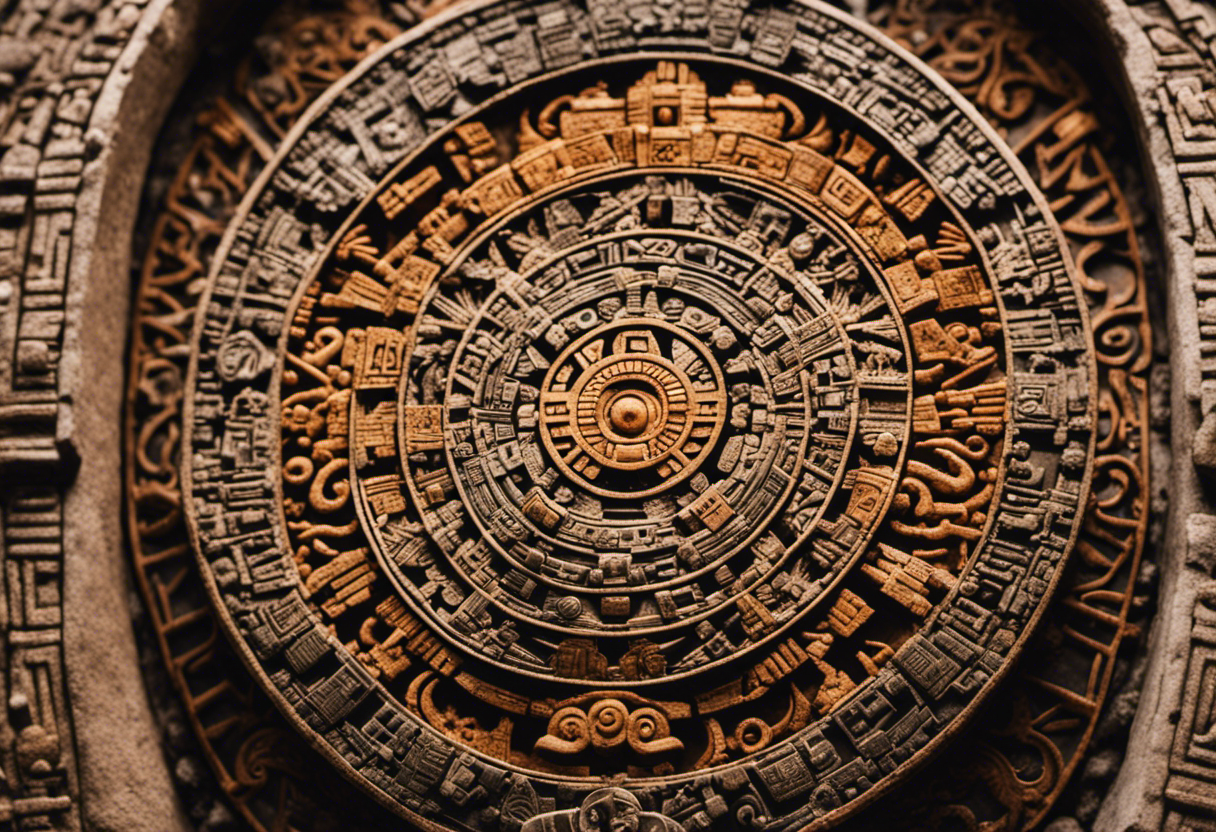

The Aztec Calendar Stone played a significant role in shaping various aspects of Aztec society. It held great religious and symbolic importance and was closely associated with both religious ceremonies and agricultural practices.
In terms of religious ceremonies, the Calendar Stone served as a central focal point. It was believed to represent the sun god, Tonatiuh, and was used in ceremonies dedicated to him. These ceremonies were crucial for the Aztecs as they sought to maintain the favor of the gods and ensure the continuation of life and prosperity.
The intricate carvings on the stone, depicting various deities and celestial symbols, provided a visual representation of the Aztec cosmology and the elaborate rituals conducted by the priests.
Furthermore, the Calendar Stone also played a vital role in agricultural practices. The Aztecs were highly dependent on agriculture, and their calendar system was closely tied to the cycles of planting and harvesting. The Calendar Stone served as a tool to track the seasons and determine the optimal times for agricultural activities.
Unraveling the Mysteries of the Aztec Calendar Stone
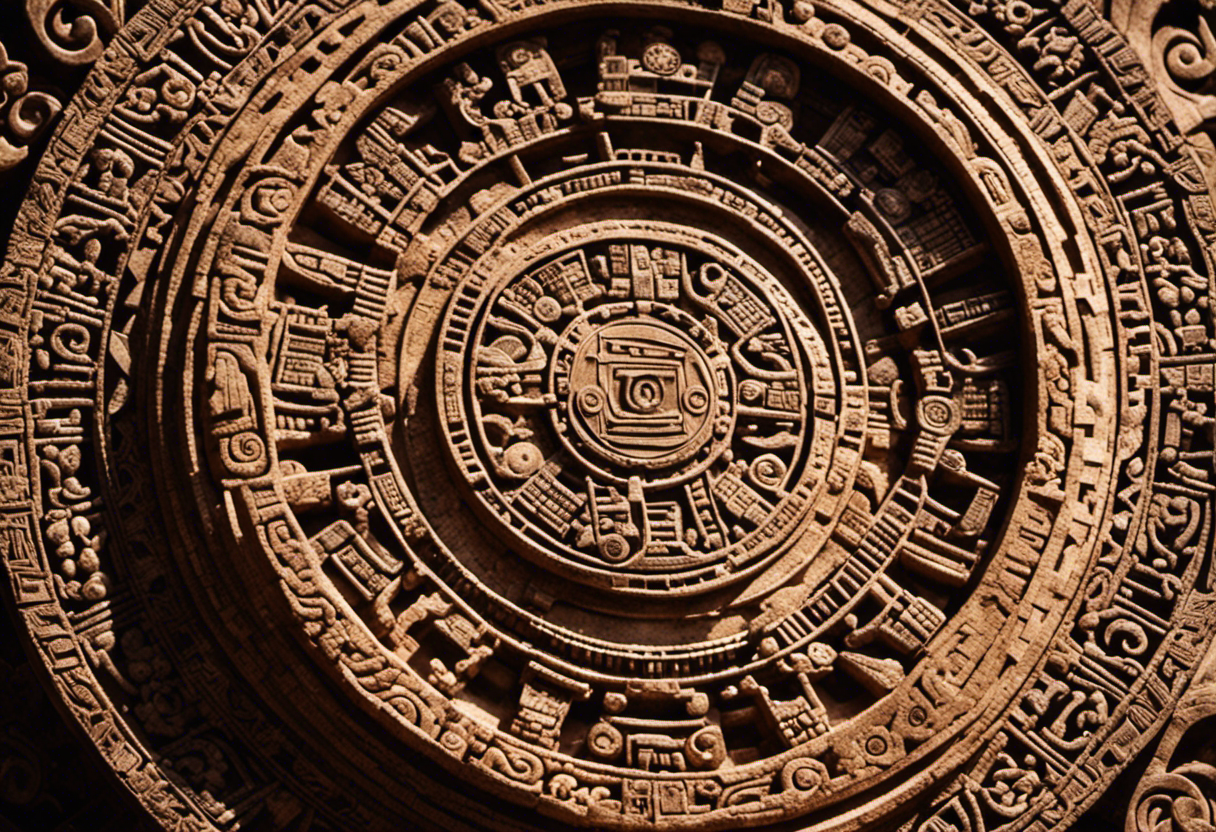

By delving into the intricate carvings and symbolism of the Aztec Calendar Stone, researchers have uncovered numerous enigmatic aspects that continue to captivate scholars and historians alike.
Aztec calendar stone research has revealed fascinating insights into the cultural and religious beliefs of the Aztecs, shedding light on their intricate understanding of time and the cosmos. Some of the key findings from the study of the Aztec Calendar Stone artifacts include:
- The meticulous craftsmanship of the stone, showcasing the Aztec’s advanced knowledge of astronomy and mathematics.
- The intricate carvings, which depict various deities, celestial bodies, and mythological events, offering a glimpse into the Aztec’s religious and cosmological beliefs.
- The stone’s complex calendar system, which encompassed multiple cycles and provided a framework for religious ceremonies, agricultural practices, and political events.
- The presence of sacrificial imagery, suggesting a connection between the calendar stone and the Aztec’s ritualistic practices.
- The ongoing debate among researchers regarding the stone’s exact purpose and significance, leading to various interpretations and theories.
Through ongoing research and analysis, scholars continue to unravel the mysteries of the Aztec Calendar Stone, offering valuable insights into the rich cultural heritage of the Aztec civilization.
Conclusion
In conclusion, the Aztec Calendar Stone remains a captivating artifact that continues to fascinate scholars and historians. Its intricate carvings and symbolic meaning provide insights into the Aztec culture and their complex calendar system.
Despite extensive research and analysis, many mysteries still surround this ancient artifact. How did the Aztecs use the calendar stone in their society? What other secrets does it hold?
The enigmatic nature of the Aztec Calendar Stone invites further exploration and sparks curiosity about the ancient civilization it represents.

